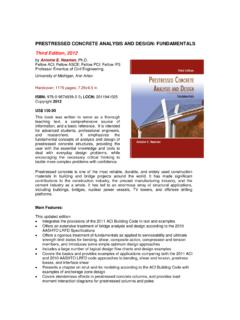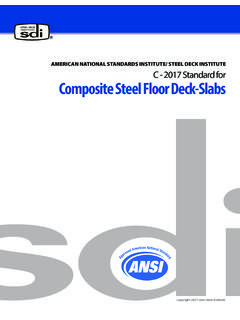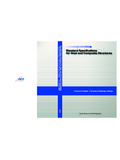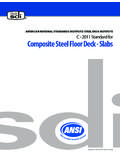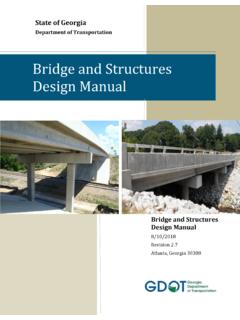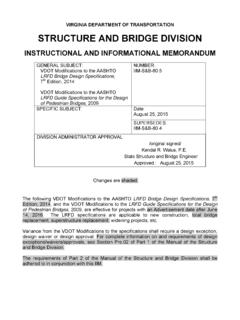Transcription of PRESTRESSED CONCRETE ANALYSIS AND DESIGN: …
1 PRESTRESSED CONCRETE ANALYSIS AND design : FUNDAMENTALS Second Edition, 2004 by Antoine E. Naaman, Fellow ACI; Fellow ASCE; Fellow PCI; Fellow IFS Professor of Civil Engineering, University of Michigan, Ann Arbor Hardcover; 1072 pages; in. ISBN: 0-96749 39-1-9; LCCN: 2004090275 Copyright 2004 US$ This 2nd Edition has essentially the same structure and similar overall content as the 3rd Edition except that it integrates the provisions of the 2002 ACI Building Code and the 1998-2002-interim AASHTO LRFD Bridge design Specifications in text and examples.
2 The 2nd Edition has about 100 pages less than the 3rd Edition. Review the DETAILS given for the 3rd Edition for additional information about key features. CONTENTS: Chapter 1 Principle and Methods of Prestressing Chapter 2 Prestressing Materials: Steel and CONCRETE Chapter 3 The Philosophy of design Chapter 4 Flexure: Working Stress ANALYSIS and design Chapter 5 Flexure: Ultimate Strength ANALYSIS and design Chapter 6 design for Shear and Torsion Chapter 7 Deflection Computation and Control Chapter 8 Computation of Prestress Losses Chapter 9 ANALYSIS and design of Composite Beams Chapter 10 Continuous Beams and Indeterminate Structures Chapter 11 PRESTRESSED CONCRETE Slabs Chapter 12 ANALYSIS and design of Tensile Members Chapter 13 ANALYSIS and design of Compression Members Chapter 14 PRESTRESSED CONCRETE Bridges Chapter 15 Strut-and-Tie Modeling Appendix A List of Symbols Appendix B Unit Conversions
3 Appendix C Typical Post-Tensioning Systems Appendix D Answers to Selected Problems Appendix E Typical Precast / PRESTRESSED Beams Index Errata Chapter 1 PRINCIPLE AND METHODS OF PRESTRESSING Introduction / Examples of Prestressing / History of PRESTRESSED CONCRETE / Prestressing Methods Pretensioning Posttensioning - Self-Stressing / Prestressing Systems / Particular Prestressing Techniques - External Prestressing - Circular Prestressing - Stage Stressing - Partial Prestressing / PRESTRESSED Versus Reinforced CONCRETE / Example / Looking Ahead / References / Problems Chapter 2 PRESTRESSING MATERIALS.
4 STEEL AND CONCRETE Reinforcing Steels / Prestressing Steel - Types of Prestressing Tendons - Production Process - Mechanical and Stress-Strain Properties Relaxation - Effects of Temperature Fatigue - Corrosion / CONCRETE Composition - Stress-Strain Curve - Mechanical Properties Shrinkage Creep Fatigue - Effects of Temperature - Steam Curing / Constitutive Modeling - Stress-Strain Curve of CONCRETE in Compression - Stress-Strain Curve of Reinforcing Steel in Tension - Stress-Strain Curve of Prestressing Steel in Tension / Concluding Remarks / References / Problems Chapter 3 THE PHILOSOPHY OF design What is design ?
5 / ANALYSIS or Investigation Versus design / design Objectives / Limit State design Philosophy / Common design Approaches - WSD (or ASD) - USD, SD, or LRFD - Plastic design or Limit design - Nonlinear design , Probabilistic design / design Codes / Loads / Allowable Stresses CONCRETE - Prestressing Steel - Reinforcing Steel / Load and Strength Reduction Factors - Load Factors - Strength Reduction Factors / Some design Comparisons: Reinforced Versus PRESTRESSED CONCRETE - Practical design Approach - C-Force and C-Line - Characteristic Response of RC, PC.
6 And PPC in Bending in the Elastic Range of Behavior - Curvature Computation - Load Balancing Feature of Prestressing / ACI Code Viewpoint Related to PRESTRESSED and Partially PRESTRESSED CONCRETE - Class Definition and Related Serviceability design Requirements - Tension Controlled and Compression Controlled Sections / Details of Reinforcement / Prestress Losses in Preliminary design / Concluding Remarks / References Chapter 4 FLEXURE: WORKING STRESS ANALYSIS AND design ANALYSIS Versus design / Concepts of Prestressing / Notations for Flexure - Example: Computation of Sectional Properties / Sign Convention - Examples / Loading Stages / Allowable Stresses / Mathematical Basis for Flexural ANALYSIS / Geometric Interpretation of the Stress Inequality Conditions / Example.
7 ANALYSIS and design of a PRESTRESSED Beam - Simply Supported T Beam - Simply Supported T Beam with Single Cantilever on One Side / Use of the Stress Inequality Conditions for the design of Section Properties / Examples of Use of Minimum Section Properties - Minimum Weight Slab - Minimum Weight Beam - Selection of Optimum Beam from a Given Set of Beams / Limiting the Eccentricity along the Span - Limit Kern Versus Central Kern - Steel Envelopes and Limit Zone Example - Limit Location of Draping Section / Some Preliminary design Tips / Cracking Moment / Limiting the Amount of PRESTRESSED Reinforcement / End Zone: Pretensioned Members - Transfer Length and Development Length - End Zone Reinforcement / End Zone: Posttensioned Members - ANALYSIS of Stresses - Anchorage Zone design - Example: design of End Zone Reinforcement / References / Problems Chapter 5 FLEXURE.
8 ULTIMATE STRENGTH ANALYSIS AND design Load-Deflection Response - RC Versus PC at Ultimate / Terminology / Flexural Types of Failures / Special Notation / General Criteria for Ultimate Strength design of Bending Members - design Criteria - Minimum Reinforcement or Minimum Moment Resistance: Code Recommendations - ACI Code Provisions for Tension-Controlled, Transition, and Compression-Controlled Sections at Increasing Levels of Reinforcement - AASHTO LRDF Recommendation on Maximum Reinforcement / Background for ANALYSIS of Sections at Ultimate - Objective Assumptions - Satisfying Equilibrium / Nominal Bending Resistance.
9 Mathematical Formulation for Rectangular Section or Rectangular Section Behavior Under-Reinforced and Tension-Controlled - Force Equilibrium - Moment Equilibrium - Solution Procedure / Example: Nominal Bending Resistance of a Rectangular Section - Partially PRESTRESSED Section - Fully PRESTRESSED Section - Unbonded Tendons / Nominal Bending Resistance: Mathematical Formulation for T-Section Behavior of Flanged Section - Condition for T-Section Behavior - Fully PRESTRESSED Section - Partially PRESTRESSED Section - Remark / Example.
10 Nominal Bending Resistance of T Section - Partially PRESTRESSED Section - Fully PRESTRESSED Section - Unbonded Tendons - Odd Case / Stress in Prestressing Steel at Nominal Bending Resistance - fps per ACI Code - fps per AASHTO LRFD Specification for Bridge design - Author s Recommendation / Nominal Bending Resistance: Under-Reinforced Section, AASHTO LRFD Code - Equilibrium Equations for Rectangular and Flanged Sections - Solution for Members with Bonded Tendons - Solution for Members with Unbonded Tendons - Solution for Members with Both Bonded and Unbonded Tendons - Example: PPC (Partially PRESTRESSED CONCRETE ) Rectangular Section with Bonded Tendons (AASHTO) - Example: PPC (Partially PRESTRESSED CONCRETE ) T Section with Bonded Tendons (AASHTO) / Nominal Moment Resistance.
